[ASEAN-Japan Special 1] 50 Years of Partnership: Interview with Hayakawa Yuho of the Southeast Asia and Pacific Department
2023.12.08
This year marks the 50th anniversary of Japan’s friendship and cooperation with the Association of Southeast Asian Nations (ASEAN). In the first article of a three-part series, Hayakawa Yuho, director general of JICA’s Southeast Asia and Pacific Department, reflects on how Japan and JICA worked with ASEAN to build trust and promote growth over the past half century and offers his vision for the future of the partnership.
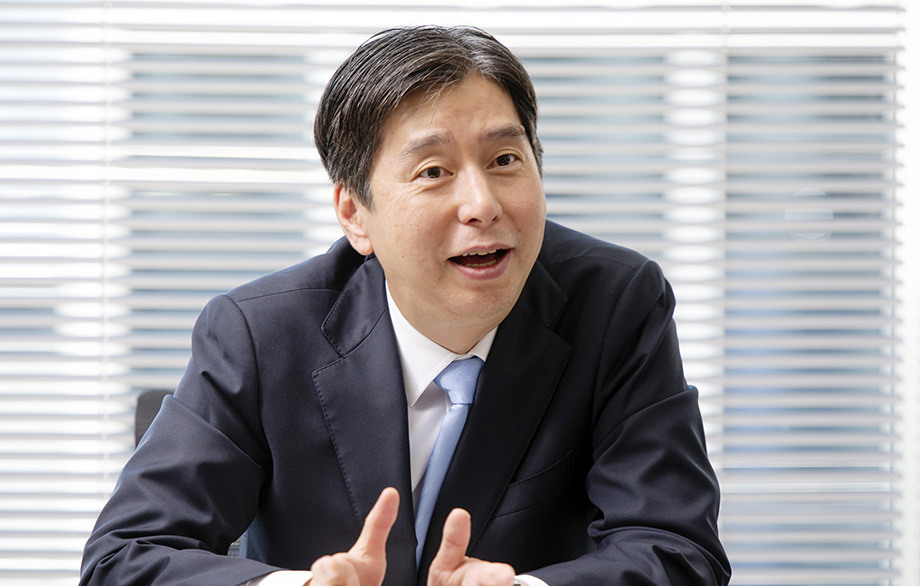
ASEAN was established in 1967 with the aim of promoting the economic growth and political stability of Southeast Asia—a region with a population today of 680 million people. While the grouping’s 10 countries have distinct languages, ethnic groups, cultures, climates, and political systems, the member states have worked together as a single community to achieve prosperity and stability while respecting each other’s diversity.
Southeast Asia’s economic growth has been remarkable. Its total GDP has increased from $660 billion in 2002 to $3.6 trillion in 2022, making the region one of the world’s major economic zones. It is internationally recognized as a growth center that is open to the world, and it is also Japan’s second largest trading partner after China.
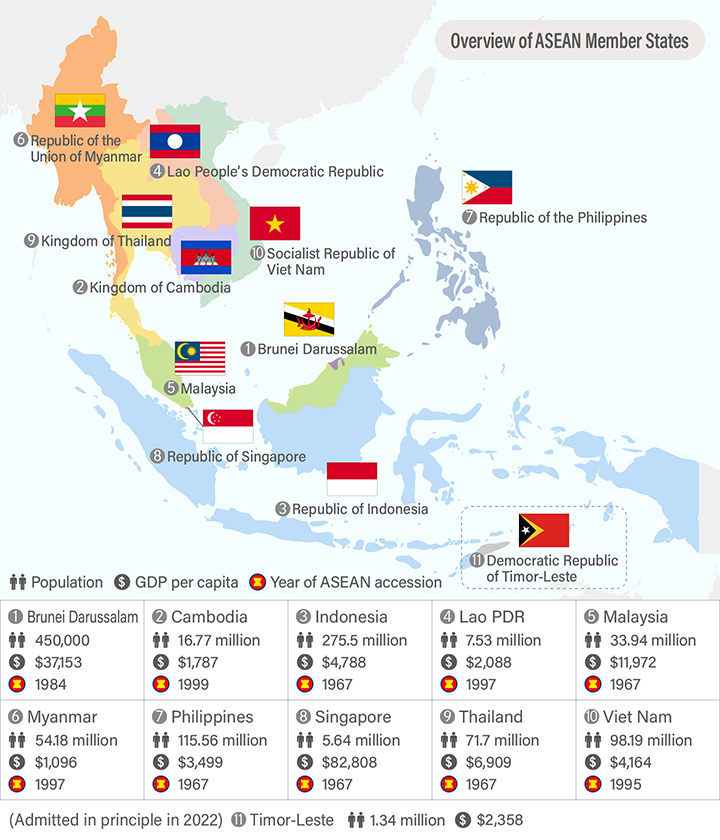
GDP per capita (nominal, US dollars) based on World Bank data for 2022.
—Just looking at the region’s GDP, which expanded 5.5-fold over the past twenty years, we can see that ASEAN’s growth has been spectacular. You were stationed in Viet Nam around twenty years ago. How do you view this development over these past two decades?
HAYAKAWA YUHO: My sense is that ASEAN countries have developed to a far greater extent than many Japanese people imagine. I spent three and a half years in Hanoi from 2002. A small shopping mall had just opened in the center of the city, and I remember seeing children visiting the mall just to ride the escalators—which were still quite rare at the time. Today, the city is full of huge shopping malls standing alongside one another. Bicycles were still the main means of transport in the late 1990s, but they’ve now been replaced by motorcycles and automobiles. The urban landscape in Hanoi and many other Southeast Asian cities is not very different from what one would expect to see in Japan.
Government and private-sector representatives from ASEAN countries regularly visit JICA’s headquarters in Tokyo, and they all have an air of authority and confidence. So, I can see that ASEAN has changed not only in its economic development and higher living standards but also in people’s mindsets.
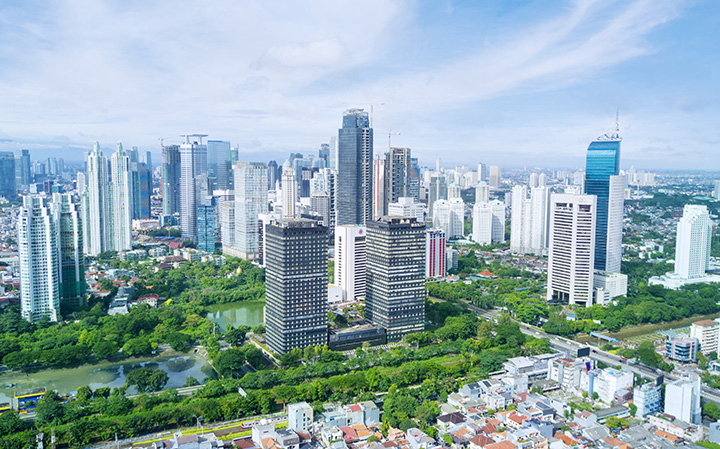
A cityscape of Jakarta, Indonesia, which hosted the most recent ASEAN Summit. (Photo: Shutterstock/Creativa Images)
—Japan can trace its friendship with ASEAN back to 1973, when Japan was rapidly increasing production of low-priced, synthetic rubber, which competed with natural rubber produced by ASEAN countries. This brought the two sides together for a dialogue over the issue of synthetic rubber exports. How has the relationship evolved over the fifty years since then?
HAYAKAWA: After the ASEAN-Japan Synthetic Rubber Forum was held, Japan announced the Fukuda Doctrine in 1977. This was extremely significant, serving as the foundation of Japan’s subsequent foreign policy toward Southeast Asia. Japan deepened its friendship and cooperation through bilateral summit and foreign ministers’ meetings. And from the 1980s, we expanded our support for the nation-building efforts of ASEAN member states through human resources development.
Japan might have been more economically advanced during the years when ASEAN countries were still developing, but we have all always been important neighbors and friends for one another—inseparable, like childhood companions. Southeast Asia has received renewed attention in recent years in the diplomatic context of ensuring the security of the Indo-Pacific region and the “China Plus One” business strategy of diversifying investments to countries besides China. But even without such factors, the relationship between Japan and Southeast Asia will remain very strong. We’ll continue to complement one another and grow together. In that regard, the ASEAN framework has played a very big role in the region. If it had not been for the establishment of ASEAN, the regional landscape, including political and economic stability and dynamic growth, would have been substantially different.
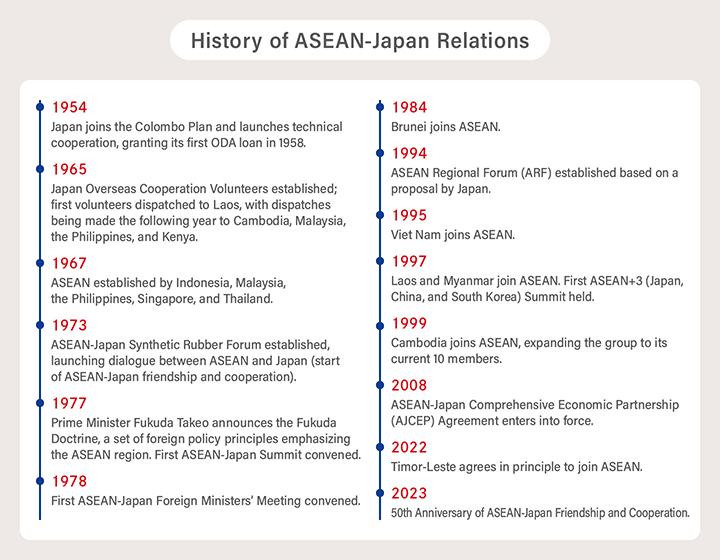
—In what ways has JICA promoted development cooperation with ASEAN over the past half century?
HAYAKAWA: JICA has been supporting infrastructure development in Southeast Asia since the 1970s, helping construct roads, airports, railways, dams, power plants, irrigation systems, and systems for water supply and sewerage to promote economic activity and raise the quality of life. Such infrastructure, renovated as needed over time, still provides the foundation for people’s daily lives and economic activities. JICA has not just contributed funds for projects but also helped prepare individual project plans and sectoral development plans from the long-term perspective. We’ve also been actively engaged in advancing technology transfers. Our cooperation has developed over the years to address various issues including basic education, development of industrial human resources, legal and judicial development, peacebuilding, and health and medical care. In recent years, we’ve further broadened our cooperation to meet the emerging needs of the ASEAN region, such as by helping countries contain COVID-19.
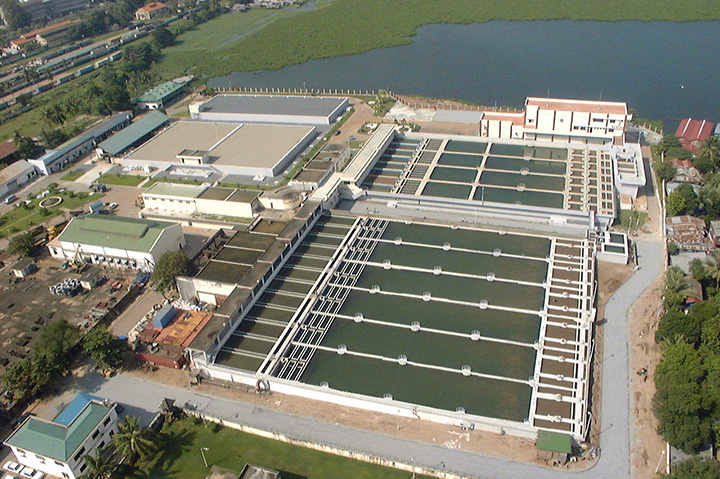
JICA supported efforts to deliver safe drinking water in Phnom Penh, Cambodia, by renovating an aging water treatment plant and improving the city’s water supply capacity.
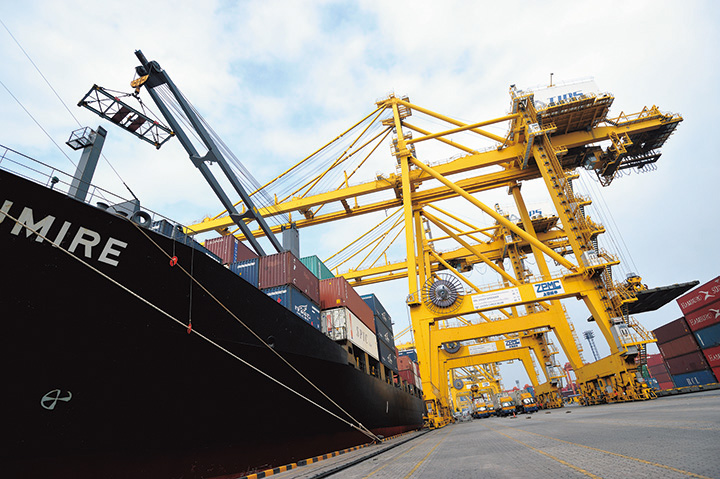
JICA has also cooperated with the development of Thailand’s biggest international port in Laem Chabang and other areas along the eastern seaboard, which has played a key role in driving the country’s economic growth. (Photo by Okuno Yasuhiko/JICA)
—How effective has JICA’s cooperation been?
HAYAKAWA: The cooperation between Southeast Asia and Japan has not just been through ODA. It’s been broad and multilayered and has included business, academic, and grassroots partnerships. On the whole, I’d say it’s been quite successful. JICA’s cooperation efforts have supported human resources development and nation building, laying the foundation for the development of the private sector in ASEAN countries. These efforts contributed greatly to the growth of their economy and society. Even more important, I believe, has been Japan’s faith in ASEAN’s growth potential and its continuous cooperation with the region over a long period.
Malaysia, Thailand, and more recently Indonesia have transitioned to upper middle-income status, and Viet Nam and the Philippines are not far behind. Back in the 1980s and 1990s, though, there were still doubts in the international community as to whether these countries could achieve steady growth. Several countries in the region that had once achieved high growth later suffered serious setbacks in the Asian financial crisis that began in 1997.The world’s development cooperation community seemed to believe that many developing countries were dependent on continuous aid for poverty reduction. Few envisioned ASEAN countries taking off on a path toward growth.
We at JICA, though, never doubted that ASEAN countries would achieve strong growth, much like Japan following World War II. That’s why we’ve embraced their aspirations for growth, shared visions, and worked together to develop pathways to reach their goals. The best features of JICA’s cooperation, I believe, have been our focus on taking a long-term perspective, respecting the ownership of the governments and people of the ASEAN countries, and working with those on the ground to promote nation-building and people-building. This way of thinking is a characteristic not just of people working in development cooperation. It’s broadly shared among Japanese stakeholders, such as those in academia, the business community, and NGOs. This has earned Japan the amity and trust of the people of Southeast Asia.
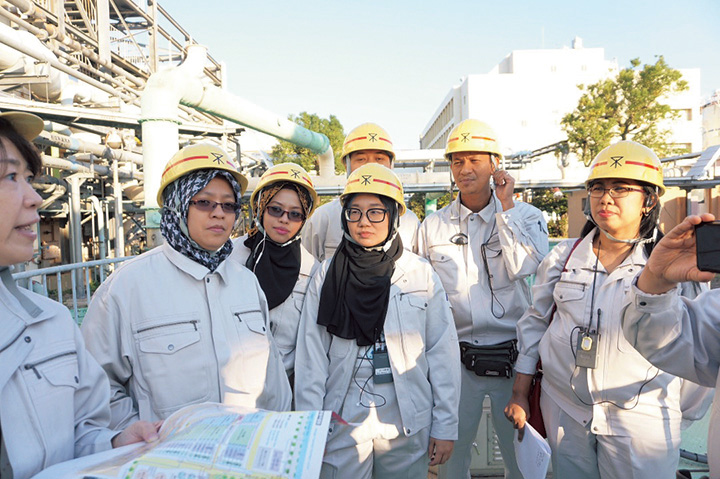
JICA offers training in surveying river water quality in Malaysia. Many bilateral human resources development projects have been advanced under Malaysia’s Look East Policy, which took its cue from Japan’s modernization drive. (Photo courtesy of Khairul Fadzilah binti Mohd. Omar)
—One of JICA’s focus areas is strengthening ASEAN connectivity. Can you explain what this means?
HAYAKAWA: One factor behind ASEAN’s remarkable development has been the region’s stability. There has been no major conflict between nations in the region since the 1990s. In keeping with their goal to turn the region from a “battlefield to marketplace,” governments have emphasized dialogue, even when agreement could not be reached, and sought solidarity where possible to build up the ASEAN framework. Regional stability has been the very source of growth. And to keep this momentum alive, efforts must be made to strengthen unity, eliminate even the possibility of conflict, and maintain a shared, long-term vision.
Connectivity is a very important concept in mitigating the growing gaps between the five countries that originally established ASEAN in 1967 and those that joined in later years. JICA supports efforts to enhance regional connectivity on three fronts: physical connectivity, through the construction of such infrastructure as roads and bridges between countries; institutional connectivity, through the building of customs clearance standards to facilitate logistics; and human connectivity, through the development of highly educated and skilled human resources, training programs, and strengthening of personal networks among universities and research institutions.
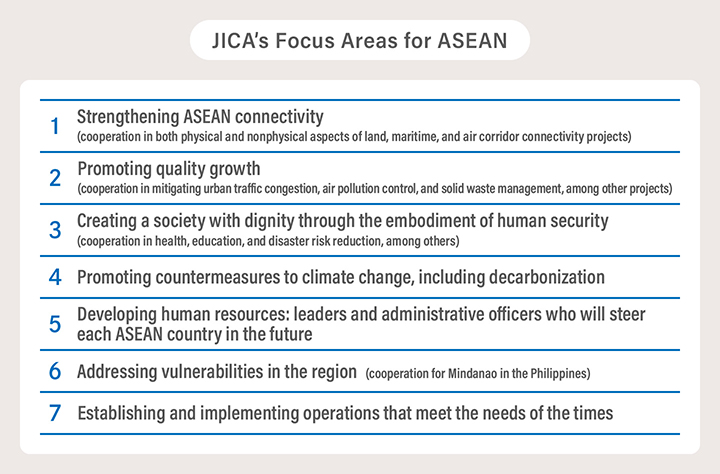
—What are some emerging challenges the ASEAN region faces in spite of its remarkable growth?
HAYAKAWA: In addition to the growing gaps within the region that I’ve just mentioned, many member states are confronted by population aging, issues relating to urbanization, and climate change. Some might see their growth rates slow down if they fall into the “middle-income trap.” JICA is committed to helping these countries overcome such a trap by assisting with the improvement of their business environment and high-value industrial growth.
These are areas where Japanese businesses have a great deal of expertise, so we hope to work even more closely with the private sector to address these issues. Japan’s business community has far stronger ties to Southeast Asia than most other regions. This is clear from the number of companies operating there, the amount invested, and the extent of human networks. Firms are well versed in regional trends, so we also need their inputs—in addition to information provided by partner countries—to get a well-rounded picture of conditions on the ground.
We believe that partnerships with the private sector can not only expand JICA’s cooperation by tapping into its financial, technical, and knowledge resources but may also enhance the effectiveness and impact of cooperation by facilitating its business activities from development and sustainability perspectives.
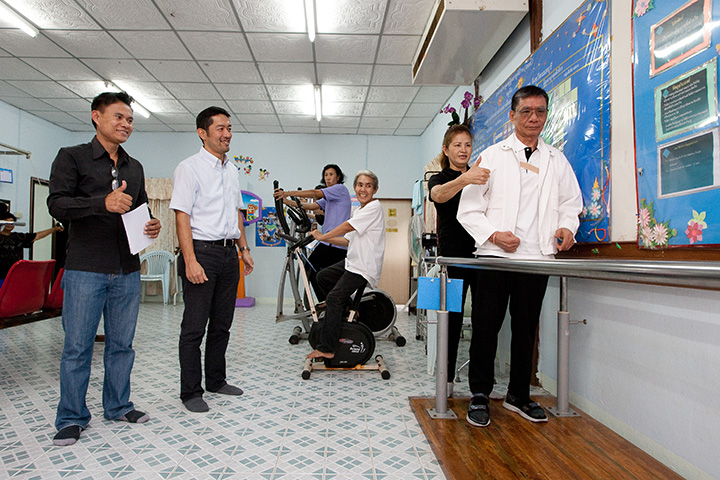
In Thailand, whose population is aging rapidly, JICA is helping institutionalize nursing-care services and advance health-promoting activities for the elderly.
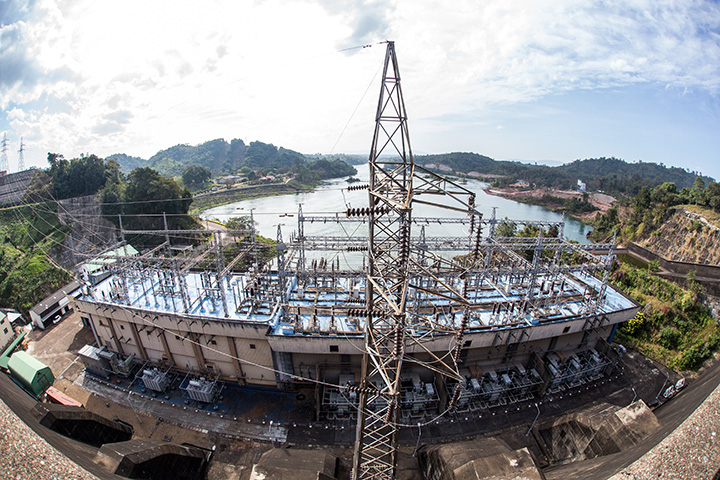
Japan’s ODA loans are being used to expand an environmentally friendly hydropower plant in Laos (right) to meet the country’s rising demand for electricity. (Photos by Kuno Shinichi/JICA)
—What roles do ASEAN countries expect Japan to play in the years ahead?
HAYAKAWA: My feeling is that they look to us to be a true and reliable partner with whom they can grow together, just as in the past. This is the very essence of the Fukuda Doctrine, which declares that Japan will strive for mutual confidence and trust through “heart-to-heart” understanding and that “Japan will be an equal partner of ASEAN and its member countries.” In 1977, when the doctrine was announced, these ideas were considered goals or disciplines that Japan should seek to fulfill, but today they’ve truly become realities.
Travel to and from ASEAN countries for both tourism and business has expanded greatly, and our ties in trade, investment, and finance, as well as in academic research and pop culture, are stronger than with many other parts of the world. JICA’s role in this context will be to serve as a catalyst to further deepen our relationship.
—How will JICA approach its future ties with ASEAN in the light of the region’s heightened expectations?
HAYAKAWA: Going forward, we need to work together on developing the region as a whole and also on addressing issues that go beyond Southeast Asia and are global in scope. We’re partnering individually with Singapore and Thailand, for example, to implement third-country training programs for participants from not just these countries but all across the region. Although operational volumes are still limited, several ASEAN member states, including Singapore, Thailand, Indonesia, and Malaysia, have established their own development cooperation functions and are evolving into “donor countries.”
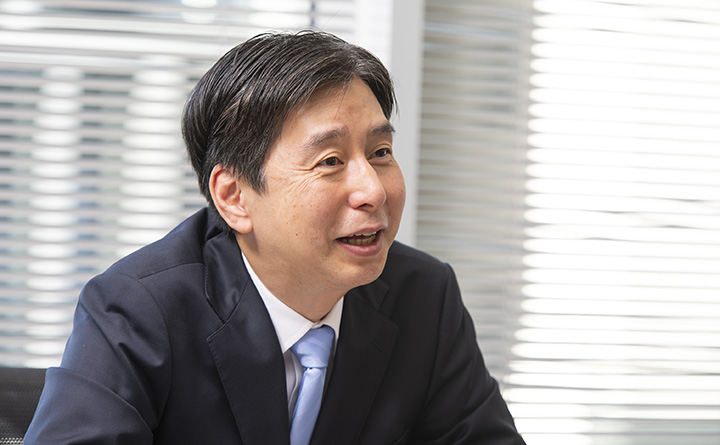
In this context, it’s vital that we keep an open ear to voices in the region, more humbly than before. Some ASEAN countries have attained enough creditworthiness to issue government bonds and raise funds directly from financial markets. So, the reason they continue to express a wish to work with JICA is not because they need financial assistance or technology transfers but because they see us as a dialogue partner with whom they share a vision for growth. By discussing and closely working with them in tackling various challenges in this region and beyond, we can enhance the impact of and create additional synergies through JICA’s cooperation.
JICA will continue to listen to ASEAN’s voices and learn what we can from Southeast Asia’s successes. We hope to remain a true partner that supports regionwide growth and that jointly creates new value in addressing regional and global issues.
scroll